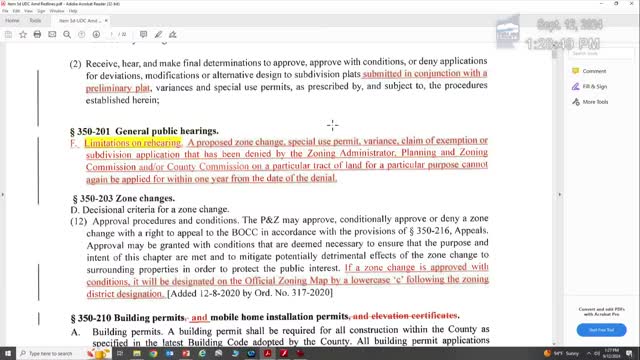Zoning Board Debates Cannabis Regulations Amid Public Concerns
September 12, 2024 | Doña Ana County, New Mexico
This article was created by AI summarizing key points discussed. AI makes mistakes, so for full details and context, please refer to the video of the full meeting. Please report any errors so we can fix them. Report an error »

In a recent government meeting, officials discussed proposed amendments to zoning regulations, particularly focusing on cannabis production and its implications for local growers. The meeting highlighted the challenges posed by the current zoning code, which restricts cannabis cultivation in proximity to residential areas, a designation that has sparked confusion and concern among agricultural producers.
One of the key points raised was the definition of \"residential area,\" which currently limits cannabis operations even if they are situated on larger agricultural parcels. For instance, a grower with a 20-acre pecan orchard may be unable to cultivate cannabis if a neighboring property, even a small one, is classified as residential. This has led to calls for a reevaluation of the zoning language to better accommodate agricultural practices while maintaining community standards.
Staff proposed a modification to the zoning code that would allow for a 300-foot buffer between cannabis operations and residential properties, measured from the operational limits rather than the property lines. This change aims to provide growers with more flexibility while still addressing community concerns about proximity to residential areas.
Public input was encouraged during the meeting, with several stakeholders expressing their views on the proposed amendments. Notably, Rick Rose, a local resident, argued that the current definition of residential areas is overly restrictive and does not accurately reflect the agricultural nature of the region. He emphasized that a single home should not define an area as predominantly residential, suggesting that the zoning regulations need to be more reflective of the community's agricultural character.
The meeting concluded with a commitment to further review the proposed changes and consider public feedback before making a final decision. The discussions underscore the ongoing balancing act between supporting local agriculture and addressing residential community concerns in zoning regulations.
One of the key points raised was the definition of \"residential area,\" which currently limits cannabis operations even if they are situated on larger agricultural parcels. For instance, a grower with a 20-acre pecan orchard may be unable to cultivate cannabis if a neighboring property, even a small one, is classified as residential. This has led to calls for a reevaluation of the zoning language to better accommodate agricultural practices while maintaining community standards.
Staff proposed a modification to the zoning code that would allow for a 300-foot buffer between cannabis operations and residential properties, measured from the operational limits rather than the property lines. This change aims to provide growers with more flexibility while still addressing community concerns about proximity to residential areas.
Public input was encouraged during the meeting, with several stakeholders expressing their views on the proposed amendments. Notably, Rick Rose, a local resident, argued that the current definition of residential areas is overly restrictive and does not accurately reflect the agricultural nature of the region. He emphasized that a single home should not define an area as predominantly residential, suggesting that the zoning regulations need to be more reflective of the community's agricultural character.
The meeting concluded with a commitment to further review the proposed changes and consider public feedback before making a final decision. The discussions underscore the ongoing balancing act between supporting local agriculture and addressing residential community concerns in zoning regulations.
View full meeting
This article is based on a recent meeting—watch the full video and explore the complete transcript for deeper insights into the discussion.
View full meeting
